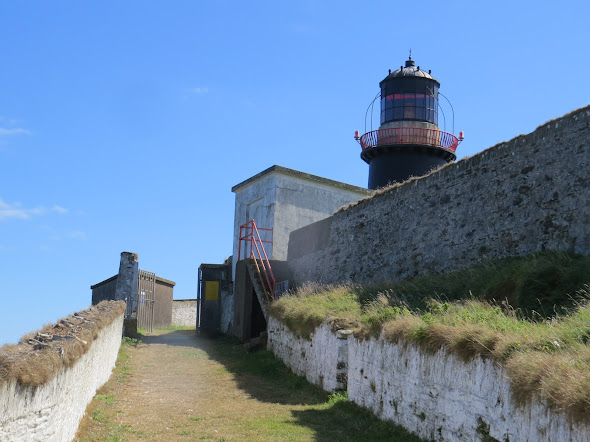Ballycotton Lighthouse Part Two - the visit
This is a follyer-upper to Ballycotton Lighthouse Part One
After an early morning drive down from Dublin to Mine Head, Youghal and the Capel Island viewing point, I negotiated the narrow main street of Ballycotton to make it down to the harbour at the appointed time of 12 o'clock on one of those idyllic summer's days that only seem to exist in your childhood memories. I met up with my fellow-travellers - Markus and his two lovely daughters from Bischofsheim in Germany and a couple who had good reason to be there - they had got engaged on the balcony of Ballycotton lighthouse several years ago and regularly come back to the scene of the crime, though they refused to reenact the event for our entertainment. Ann Marie was our personable, friendly and knowledgable Ballycotton Sea Adventures guide (my friend John Archer had done the previous tour!) and our pilot looked like he knew how to handle a boat, so it was in good spirits that we set off.
Even to a gnarled old landlubber like myself, it was a very pleasant crossing, barely ten minutes having passed before we were doubling back into the tiny pier on the northern side of the island. No wonder there are no lurid Ballycotton tales of cannibalistic lightkeepers being marooned for years due to foul weather. Despite its small size, this was actually the main landing place, the little pier on the west side of the island being capable of handling only toy boats that can fit in your bath.
It was Instruction 257 in the Lightkeeper's Manual to keep something rusty at the landing place and these giant curling stones obviously fulfilled the criteria
We then ascended the rather steep, zigzag path up to the lighthouse, pausing at the 'elbow' only to admire the view and have a quick sleep. In the picture below, the white wall was the place the keepers used to milk the goats on the island. The goats are still here, though quite feral. I'm presuming they milk each other nowadays, though I'm no David Attenborough.
The feral goats on the island with Billy trying to keep his pretty head low and avoid being a hero
The old keepers' cottages (that's the old cottages belonging to the keepers, not the cottages of the old keepers) still seem in fairly good nick, despite not having been lived in for many years. They were evidently constructed before transparent windows were invented, as they wouldn't let much light in, I'd imagine.
And so into the tower and up the spiral staircase, an object that is impossible to describe without using your finger, so I won't even try. It isn't one of the larger towers by any means, only 15 meters in height but then it doesn't have to be, sitting proudly on the summit of the island, its lantern flashing out one beam every ten seconds 59 meters above High Tide. There is also a red light which spells danger, according to the aptly named maritime expert Billy Ocean...

The views from the balcony were magnificent (have you ever known a lighthouse where the balcony views were only so-so?) and Mine Head and the stump on Capel Island were clearly visible. The shoreline to the north was quite beautiful and seems to be a potential holiday destination in the future with beaches and cliffs and hills in all the right places. Back towards Ballycotton, Little Island seemed to stretch almost to the harbour (it is actually walkable at low tide) and the village itself basked in the midday sun like a village basking in the midday sun.
The yellow house is built on the harbour and is the dwelling place of the family who had the contract for servicing the lighthouse in the boats. The Lane family, I was told. Behind it is the lifeboat station, a well-deserved plaque to the heroes of the Daunt Rock Lightship rescue adorning its wall.
From the top of the tower, we had an even better view of that world-renowned architectural wonder of the world, the Ballycotton Hilton. From our elevated position, it was difficult to avoid swooning over the sheer elegance of this finely crafted edifice. Built in 1970s Secondary School style by some of the finest Italian workmen of the day, this became the new keepers' accommodation (that's the new accommodation for keepers - you get the rest) Blending in organically with the natural colours and contours of the island, I was pleased to observe, peering in through the windows, that Instruction 312 of the Lightkeepers' Manual - there should be paint cans visible through the windows of all abandoned houses - was being rigorously observed.
We probably could have stayed all afternoon but eventually we took the boat back, and were surprised by an impromptu and quite delightful circumnavigation of the island, courtesy of our kindly boatman, whose name I have - oh the shame - forgotten. Thanks to this random act of kindness, I was able to see the tiny second landing place on the north side of the island.
At the risk of boring you all to tears, I will do a third post on Ballycotton later, detailing the history of this charming and very black lighthouse.






















Comments
Post a Comment